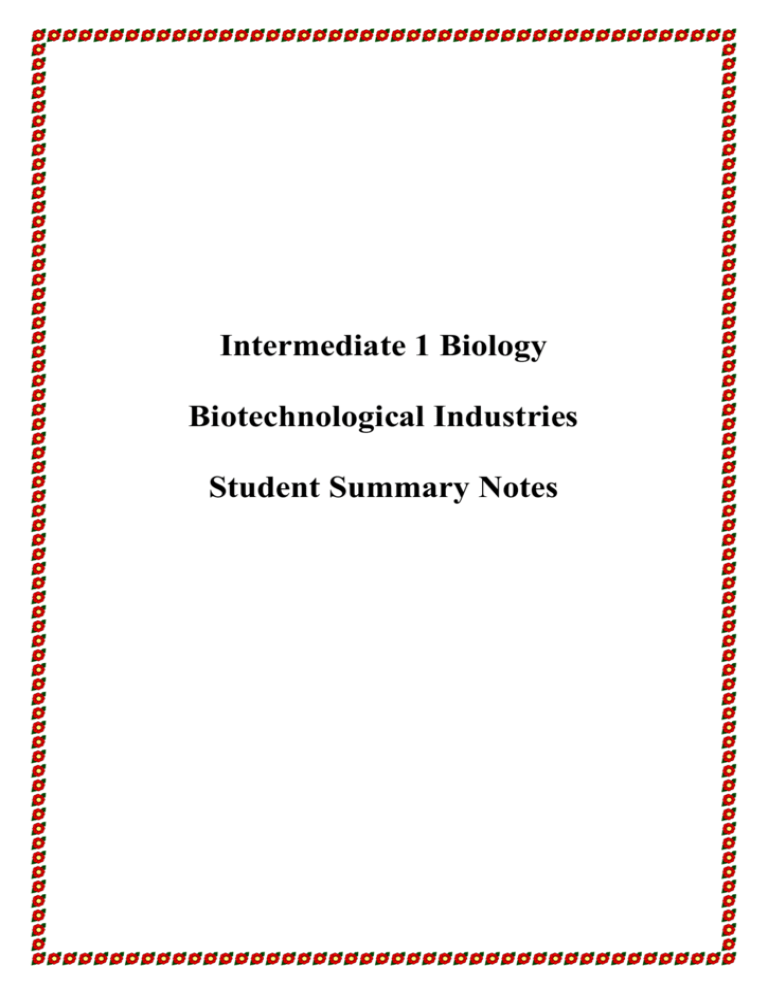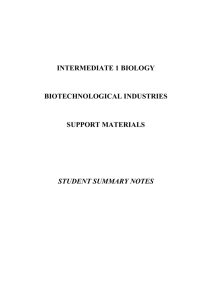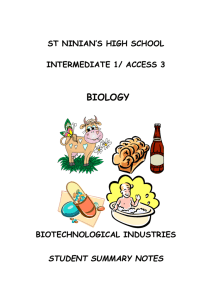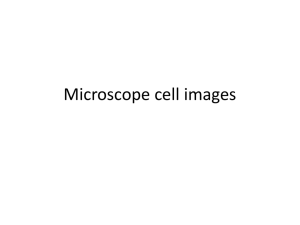Intermediate 1 Biology
advertisement

Intermediate 1 Biology Biotechnological Industries Student Summary Notes 1. Dairy Industries Milk Milk is an important part of a balanced diet. It contains many important nutrients and because of this it is also an ideal place for bacteria to grow. To kill bacteria all our milk is heat-treated in some way. The heat treatment should kill all the harmful bacteria. Microbial tests are carried out on milk to test if it is fit for human consumption. The resazurin test is carried out to demonstrate the presence of bacteria. All milk is tested using a resazurin dye test to make sure that it is fit to drink before it reaches our doorsteps or supermarket shelves. The resazurin dye test 1. 3cm of resazurin is added to 3cm of milk and then placed in a water bath for 20 minutes. 2. The colour of the solution is recorded every 2 minutes. 3. The colour after 20 minutes indicates the quality of the milk. Colour of sample after 20 minutes Milk quality Remains purple Good Becomes mauve Satisfactory Becomes pink Poor Becomes clear Unfit for consumption 65 heat treatment There are 2 main forms of heat treatment: 1. Pasteurisation Pasteurisation is the most widely used heat-treatment. 86% of the milk sold in this country is pasteurised. The milk is first heated to 72°C for at least 15 seconds. It is then quickly cooled to a temperature below 10°C. It is then packaged in bottles, cartons or containers and distributed. Pasteurised milk will keep for up to five days if it is stored in a fridge. 2. Ultra High Temperature (UHT) UHT milk is heated to a higher temperature than pasteurised milk. UHT milk is heated to between 135°C and 142°C for 2 to 5 seconds. This processing alters the taste of the milk. Fat content of milk Milk can also be graded by its fat content so that we can buy skimmed milk, evaporated milk etc. Whole milk has had none of the fat removed. Semi-skimmed has had around half of the fat removed. Skimmed milk has had almost all the fat removed. Evaporated milk has had about half of the water removed from the milk and is used in a similar way to cream. When the fat is removed from the milk there is also a reduction in vitamins such as Vitamin A. For this reason it is not advisable to give skimmed or semi-skimmed milk to young children. Another method of preserving milk is to convert it into yoghurt or cheese. These natural yoghurts can be used as the starter’ culture to allow us to make yoghurt in the lab. Method 1 Milk is heated to 43°C to encourage yoghurt bacteria to grow. 2 1 teaspoon of the starter culture is added and covered with cling film. 3 The yoghurt is incubated at 43°C for 7 hours. 4 Once formed it is cooled in the fridge for 4 hours. The starter cultures contain bacteria. When the bacteria grow they make lactic acid from the sugar in the milk. The lactic acid gives the yoghurt its taste and makes the milk thicker. 66 Cheese There are several steps in the manufacture of cheese: the milk is pasteurised to kill most of the bacteria special bacteria are added to convert the milk sugar into lactic acid enzymes are added to clot the proteins in milk. The milk clotting enzymes (rennet), which were used originally, always came from animals such as calves. Nowadays the enzymes used in cheese making can come from a variety of different sources. calf rennet Rennet obtained from calves Advantages: used successfully for hundreds of years. Disadvantages: an animal product involving slaughter of animals and possible risk of disease. fungal rennet An enzyme which is similar to rennet but which is produced by a fungus. Advantages: cheap, large amounts produced, accepted by vegetarians. Disadvantages: taste GM yeast rennet An enzyme which is produced by yeast which have been genetically modified to produce rennet. Advantages: does not involve animals, approved by vegetarians, rennet produced is identical to animal rennet. Disadvantages: public concern about GM foods 67 Environmental Impact: Monitoring waste When cheese is made, the enzyme rennet causes the milk proteins to clot. These solids are called the curds. The liquid left after the protein clots is called the whey. The whey contains sugars. If the whey was released untreated into the rivers the bacteria would use the sugars as a food source, reproduce and increase in number. These bacteria would use up the oxygen in the rivers and there would be less oxygen available for the fish and all the other living organisms. To protect the environment the whey must either be treated before it is released into the rivers or it must be used for something else (upgraded). The whey can be treated by using bacteria which feed on the whey to turn it into carbon- dioxide and water. The bacteria are then removed and the cleaner water is discharged into the river. The river water is tested to make sure that the oxygen level is satisfactory. Upgrading whey Whey can be used as a medium for growing yeast. The whey can be used in industry. Some types of yeast feed on whey and if they are given the right conditions they change the sugars in the whey into alcohol. This type of alcohol is creamy and is found in products such as Baileys Irish Cream. 68 2. Yeast Industries Bread Yeast is a one-celled fungus. For thousands of years humans have been using yeast to make bread. Yeast is added to flour to make the dough rise. Both dried yeast and fresh yeast is used in baking. Yeast is a living organism and when it respires it gives out carbon-dioxide. It is this gas from the yeast which makes the bread rise. Pure cultures of yeast cells can be grown in huge numbers in large vessels called fermenters. The yeast can then be used by the baking industry to make bread or by the brewing industry to make beer. Beer Beer is an alcoholic drink made from water, barley, sugar, hops and yeast. In Britain today there are over 1200 different brands of beer. Each brand is different and has its own flavour. Around half the beer which is drunk is today is lager and the other half is bitter, ale and stout. Different beers are brewed in different ways and they have different alcohol contents. When beer is being made it is the yeast which uses the sugars and converts them into alcohol. When this happens the yeast also produce large amounts of the gas carbon-dioxide and this will make the beer fizzy. Ales and lagers are brewed with different strains of yeast. These yeasts use the sugars at different temperatures and at different rates. Ale yeasts grow for six days at a temperature of 12-18°C and they rise to the top of the vessel in which they are growing. Lager yeasts grow at only 8-12°C for about 3 weeks and sink to the bottom of the vessel in which they are growing. 69 All beer must be matured before it can be drunk. Maturing the beer improves its flavour, removes any solid material and gives it its sparkle. The beer is either cask conditioned - often called real ale - or brewery conditioned - keg beers, bottles and cans. Cask conditioned beer Brewery conditioned beer Example of beer produced Real ale Storage Conditions Casks of wood or steel Yeasts still present and provided with sugar to feed on Keg beers bottles cans Large tanks Yeast and solid materials removed Description of beer Dark coloured Highly flavoured Clear and bright Has a longer shelf life Fermented milk drinks In many countries it is difficult to keep milk and yoghurt fresh. One way of solving this problem is to ferment the milk slightly to make it alcoholic. Yeast is used to turn the sugars in the milk into alcohol. In some areas of the world a drink called kefir is made in this way. Drinking kefir is like drinking a refreshing, fizzy, slightly alcoholic, yoghurt drink. Immobilisation This is a technique used to trap an enzyme and some yeast into a jelly bead and can be used in the production of fermented milk drinks such as kefir. Method 1. A solution of sodium alginate is used to trap the enzyme and/or yeast to make a jelly bead. 2. The beads are then hardened by dropping them into a solution of calcium chloride. This is an important method because after the reaction the beads can be separated from the end product, washed and used again. This saves money because the enzymes can be very expensive. The bead can be easily separated from the product. This would not be possible if the enzyme and the yeast were free in the yoghurt drink rather than trapped in a bead. 70 Food flavouring In addition to using yeast for making bread and alcoholic drinks, yeast can be used for flavouring food. Some examples of foods which have yeast flavourings added are soups crisps and snacks. Meat flavoured crisps e.g. chicken, bacon, beef. Oxo cubes Marmite Food colouring Wild salmon and trout have pink flesh from the pink coloured prawns and shrimps which they eat. Farmed salmon and trout would be a dull grey colour if they were not fed a red dye in their diet just before they are killed. The dye does not affect the way that the fish tastes and it is only added because people do not want to eat grey salmon or trout. It is now possible to give the salmon a red colour by feeding them red yeast. The fish then take on a pink colour in their flesh. 71 Environmental Impact: Monitoring waste Waste from the yeast based industries has the same effect on rivers as whey. It is very important that the waste from yeast industries is not released into rivers. The yeast would provide food for bacteria and the rivers would become polluted i.e. the bacteria would reproduce and increase in number which would result in a reduction in oxygen available for other organisms. Yeast industries treat all their waste and much of it is upgraded and used for animal feed. The yeast are fed on waste products and then processed to make animal feed e.g. cattle cake. This means that the water leaving the factory can be put into the river without causing pollution. Before the water is put into the river it is tested to make sure that it will not cause pollution. The Methylene Blue Test 1. Three drops of methylene blue dye is added to 15 cm of the water sample. 2. The sample is kept airtight and the colour is recorded over a period of 4-5 days. Time Colour change Water Condition Pollution Scale Immediate Blue to clear Dangerous to put into river Very polluted 2-3 days Blue to clear Dangerous to put into river Very polluted Blue to clear Needs further treatment before release into river Slightly polluted Still clear Safe to be released into river Not polluted 4-5 days 4-5 days 72 3. Detergent Industries Biological washing powders The word detergent means something which cleans’. So it includes soaps, washing up liquid and washing powder. Some washing powders are known as biological washing powders. Biological washing powders contain enzymes. Enzymes are produced in fermenters and are added to the washing powder because they improve the way in which it cleans. In a biological washing powder only about 1% of the powder is enzymes. The remaining part of the powder contains things such as water softeners, bleach and chemicals which act at the surface to help the water to get into the clothes. The enzymes found in washing powder are produced in large quantities by bacteria. Bacteria are tiny living organisms found in almost every place on earth. Scientists have looked at hundreds of bacteria until they found ones which were harmless and which produce enzymes. Once they found the right bacteria they then had to produce huge quantities of them. Bacteria grow very rapidly if they are given the right conditions. The bacteria used to produce washing powder enzymes are grown (cultured) in huge industrial fermenters. At the end of the process the enzymes have to be separated from the bacterial cells. 73 The use of enzymes in washing powders The enzymes in washing powders digest the stains in the same way that enzymes in your gut help to digest your food. Different enzymes are added to digest different stains. For example fat digesting enzymes are added to digest fatty stains and starch digesting enzymes are added to digest starchy stains. The enzymes themselves make up a very small part of the powder but they make up a large part of the cleaning power of the powder. When powders containing enzymes first came into the shops some people found that the had an allergic reaction to the powder causing skin rashes, eczema and asthma. Once this was discovered the detergent industry introduced new powders where the enzymes had been enclosed in a harmless coating to prevent allergic reactions. Enzymes in washing powders are now all coated with a waxy substance and they form granules. The addition of enzymes to washing powders means that we can all have cleaner clothes as the stains are digested. Another major benefit is that these biological powders work best at low temperatures and this saves energy. In the past before enzymes were added to washing powders the temperature of the water had to be much higher before the clothes would become clean. The enzymes in the biological washing powders work best at temperatures of between 40°C and about 55°C. The enzymes are destroyed at temperatures above 60°C. The lower temperatures used in washing with biological powders are also kinder on clothes as high temperatures can damage delicate fabrics. 74 Environmental Impact: Monitoring waste Energy is used in all parts of the production, packaging and transporting of detergents but by far the greatest use of energy is in the home of the consumer. Heating the water for the washing machine, the wash cycle, tumble drying and ironing all use up energy. This means that it costs the consumer a lot of money and has a great impact on the environment. NB To provide all the electricity and energy needed by the consumer the power stations burn coal, oil and gas which give off gases such as carbon dioxide and sulphur dioxide which damage the environment. Washing clothes at low temperatures is a very important part of saving energy. Less fuel will be used and this is good news for the consumer and for the environment. Detergents all end up in the environment when they are flushed away as waste water. Detergents can be toxic to wildlife. The manufacturers test their products to see that they would not harm the fish or the other living organisms found in our rivers. Detergents containing phosphates and sulphates will pollute rivers. This will cause tiny plants called algae to ‘bloom’ (to reproduce). When the algae die, bacteria feed on them, increase in number and use up the oxygen. As a result other animals such as fish die. The detergent industries have their own mini sewage plants where they check what happens to the ingredients in the detergents when they pass through the sewage works. Sewage plants could remove the phosphates and sulphates to reduce their environmental impact. The environmental impact of releasing detergents can also be reduced by using low phosphate detergents. 75 4. Pharmaceutical Industries Antibiotics Antibiotics are produced by soil fungi to prevent the growth of competing bacteria. Antibiotics are compounds which kill bacteria. They were discovered by Alexander Fleming. There are many different types of antibiotic. One of the most common antibiotics is known as penicillin. Around the time of the Second World War two other British scientists (Florey and Chain) managed to produce penicillin on an industrial scale. Antibiotics then became known as the ‘wonder drug’ because they cured so many people who would have previously died. Antibiotics can kill bacteria but not viruses so they might help you if you have a ‘strep’ throat but not if you have a cold or flu. To meet the massive demand for antibiotics in the modern world, huge fermenters holding over 200,000 litres have been designed. Careful attention has been paid to produce the best growth conditions. The vessels are automated and controlled by computers to provide the correct temperature, pH, oxygen concentration and food supply Sterile conditions must be maintained in the fermenter. Growth conditions are altered automatically by the computers for example if the temperature in the fermenter becomes too warm the computer detects the change and cools down the mixture. Finally the antibiotic has to be purified - this involves filtering and solvent extraction. Genetic modification is a new technology which alters the genes found in living things e.g. the gene for penicillin is inserted into bacteria which are then grown in fermenters to produce large quantities of penicillin. Genetic modification can be used to produce new antibiotics which will be more effective for fighting disease. Different antibiotics are effective against different infections. Penicillin is used to treat a wide range of infections including respiratory infections. 76 When antibiotics first appeared they were considered to be the wonder drugs but after some time it was found that some infections became resistant to the antibiotic. This means that the drug no longer kills the bacteria which is causing the infection. This has happened because of over-use of penicillin and it is a very worrying trend. People are now also concerned about the over-use of antibiotics in agriculture and veterinary practice. The same drugs are used in animals as in humans and the concern is that over-use of antibiotics in animals might lead to more resistant strains of bacteria. There is continual pressure to try to produce new antibiotics which bacteria are not resistant to. Anti-fun gals Some infections are caused by microbes known as fungi. Some common fungal infections are athletes foot and thrush. Drugs known as anti-fungals can be used to treat these infections. The anti-fungal treatment slows down or stops the growth of the infection. 77









